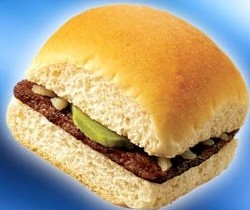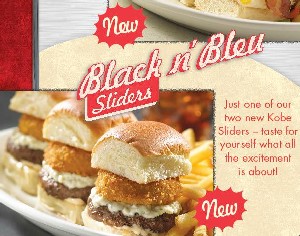Maybe the reason we embrace burgers so passionately is that the burger is an American invention with a long, proud history starting in the 19th century and withstanding the test of time. When entrepreneurs got a hold of it, it became ubiquitous. When fern bars got a hold of it, it became gourmet. When regional players got a hold of it, a raft of new flavor profiles emerged. When fine dining got a hold of it, it went upscale. But when the chefs got a hold of it, all bets were off. What started in the Midwest circa 1890 has been embraced by both coasts and everywhere in between:
 ♦ In 1921, White Castle introduced little square burgers, later nicknamed sliders, in Wichita, Kan.
♦ In 1921, White Castle introduced little square burgers, later nicknamed sliders, in Wichita, Kan.
♦ In 1932, Krystal followed in Chattanooga, Tenn.
♦ In 1934, Steak ‘n Shake appeared in Normal, Ill., of all places.
♦ In 1940, the first McDonald’s opened in San Bernardino, Calif., and the next year, Carl’s Jr. appeared in LA.
♦ In 1948, In-N-Out opened in Baldwin Park and Coco’s Famous Burgers in Newport Beach, Calif.
♦ In 1951, Jack in the Box popped up in San Diego.
♦ In 1954, Burger King began flame-grilling burgers in Miami.
♦ In 1961, Ray Kroc’s purchase of McDonald’s began the proliferation of the golden arches brand.
♦ In 1965, burgers went full service when T.G.I. Friday’s opened in New York City.
♦ In 1969, Wendy’s introduced big square burgers to Columbus, Ohio; Red Robin brought gourmet burgers to the West Coast, and Habit Burger Grill opened in Santa Barbara.
♦ In 1970, R.J. Grunts planted the seed for Lettuce Entertainment success in Chicago.
♦ In 1972, Houlihan’s started in Kansas City and Max & Erma’s in Columbus, Ohio.
♦ In 1975, Chili’s put a Texas spin on burgers.
♦ In 1982, Island’s brought Malibu Burgers to LA, and Ruby’s Diner appeared on Balboa Pier.
♦ In 1984, Culver’s brought ButterBurgers to Wisconsin.
♦ In 1986, Five Guys showed up in Arlington, Va., and Johnny Rockets in LA.
 All that said, you would think that there was nothing more to be said about this simple, craveable sandwich, but that is hardly the case. This new millennium has brought new game changers:
All that said, you would think that there was nothing more to be said about this simple, craveable sandwich, but that is hardly the case. This new millennium has brought new game changers:
♦ The upscaling of fast food with the appearance of Angus burgers. (As my sister reports from a consumer viewpoint, “Now it’s Angus this, and Angus that.â€) Burger King went upscale in 2004 (now calling them steak burgers), McDonald’s introduced Angus in 2009, and Ruby’s Diner is now featuring Kobe Sliders!
I find it fascinating that after years and years of chasing the elusive dinner business with tests of almost everything, including pizza, fast food has finally discovered the obvious: Be true to your brand by doing what you do best–do adinner-worthy burger.
♦ The downscaling of fine dining with the emergence of upscale Happy Hour burgers like Morton’s or McCormick & Schmick’s $1.95 half-pound cheeseburger.
♦ The rebirth of the humble slider at full-service restaurants…for a meal, a deal or a perfectly splitable appetizer.
♦ But by far the most intriguing game changer is the impact of chefs, which we’ll get to in Part II.
Until next time, I’d love to hear your thoughts.
